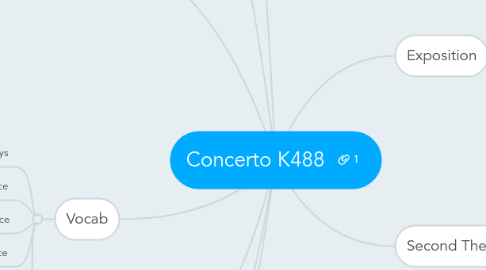Concerto K488
Phillip CONRADにより


1. Piano exposition
1.1. Very detailed
1.2. Quick, fast, moving in steps, scalic movements
2. Codetta
2.1. In minor scale, then modulates back to the major.
3. Transition Theme
3.1. Bar 99 Transition to Second Subject
3.2. In B major, then perfect cadence to transition to E major
3.3. Bar 114 End of Second Subject, different codetta
4. Vocab
4.1. Tutti: Whole orchestra plays
4.2. Perfect Cadence
4.3. Imperfect Cadence
4.4. Plagal Cadence
4.5. Interrupted Cadence
5. Bars
5.1. Bar 133-136
5.1.1. Key in particular
5.1.1.1. E major
5.2. Bar 156-172
5.2.1. Sudden and Abrupt Change
5.2.1.1. E Minor
5.3. Bar 160-161
5.3.1. How does Mozart jump between unrelated keys
5.4. Bar 170-175
5.4.1. Piano part, 1 chord per bar, identify
5.4.1.1. 170
5.4.1.1.1. E 7th Dominant
5.4.1.2. 171
5.4.1.2.1. G major (G chord)
5.4.1.3. 172
5.4.1.3.1. C major
5.4.1.4. 173
5.4.1.4.1. F major chord (F base, octave)
5.5. Bar 93
5.5.1. B major arpeggio
5.6. Bar 143
5.6.1. Theme D
6. Others
6.1. Look at the base instruments which will tell you the root chord.
6.2. FCGDAEB
6.3. 5-7 chord has an extra note, dominant seventh
6.4. 1. Major
6.5. 2. Minor
6.6. 3. Minor
6.7. 4. Major
6.8. 5. Major (Dominant Chord, plagal cadence)
6.9. 6. Minor
7. Recapitulation
8. Exposition
8.1. A major
8.2. Starts with Theme A
8.3. Allegro
8.4. Clarinet transposed from A into C
8.4.1. Minor 3rd Down

